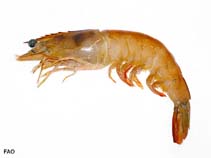Penaeus subtilis (Pérez Farfante, 1967)
Southern brown shrimp
Classification / Names Populärnamn | synonymer | CoL | ITIS | WoRMS
Malacostraca | Decapoda | Penaeidae
Environment: milieu / climate zone / djupintervall / distribution range Ekologi
; brackvatten; djupintervall 1 - 190 m (Ref. 8). Tropical; 23°N - 24°S, 86°W - 34°W
Distribution Länder | FAO områden | Ekosystem | Förekomster | Utplanteringar
Western Atlantic: from the Antilles and Honduras to Brazil.
Length at first maturity / Size / Weight / Age
Könsmognad: Lm 5.8, range 13 - ? cm Max length : 16.5 cm TL hane/ej könsbestämd; (Ref. 8); 20.5 cm TL (female)
Life cycle and mating behavior Könsmognad | Reproduktion | Lek | Eggs | Fecundity | Larvae
Main reference
referenser | Koordinator | Medarbetare
Holthuis, L.B. 1980 FAO Species Catalogue. Vol. 1. Shrimps and prawns of the world. An annotated catalogue of species of interest to fisheries. FAO Fish. Synop. 125(1):271 p. Rome: FAO. (Ref. 8)
IUCN Red List Status
(Ref. 130435: Version 2025-1)
CITES status (Ref. 108899)
CMS (Ref. 116361)
Threat to humans
Human uses
Fiskeri: kommersiell
FAO - fiskeri: landings, species profile | FIRMS (Stock assessments) | FishSource | Sea Around Us
Verktyg
Ytterligare information
Födosammansättning
Födointag
Predatorer
Max. ages / sizes
Length-weight rel.
Length-length rel.
Length-frequencies
Mass conversion
Abundans
Internet-källor
BHL | BOLD Systems | CISTI | DiscoverLife | FAO(fiskeri: species profile; publication : search) | Fishipedia | GenBank (genome, nucleotide) | GloBI | Gomexsi | Google Books | Google Scholar | Google | PubMed | Tree of Life | Wikipedia (Go, sök) | Zoological Record



